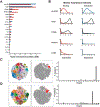Mixed-effects association of single cells identifies an expanded effector CD4+ T cell subset in rheumatoid arthritis
- PMID: 30333237
- PMCID: PMC6448773
- DOI: 10.1126/scitranslmed.aaq0305
Mixed-effects association of single cells identifies an expanded effector CD4+ T cell subset in rheumatoid arthritis
Abstract
High-dimensional single-cell analyses have improved the ability to resolve complex mixtures of cells from human disease samples; however, identifying disease-associated cell types or cell states in patient samples remains challenging because of technical and interindividual variation. Here, we present mixed-effects modeling of associations of single cells (MASC), a reverse single-cell association strategy for testing whether case-control status influences the membership of single cells in any of multiple cellular subsets while accounting for technical confounders and biological variation. Applying MASC to mass cytometry analyses of CD4+ T cells from the blood of rheumatoid arthritis (RA) patients and controls revealed a significantly expanded population of CD4+ T cells, identified as CD27- HLA-DR+ effector memory cells, in RA patients (odds ratio, 1.7; P = 1.1 × 10-3). The frequency of CD27- HLA-DR+ cells was similarly elevated in blood samples from a second RA patient cohort, and CD27- HLA-DR+ cell frequency decreased in RA patients who responded to immunosuppressive therapy. Mass cytometry and flow cytometry analyses indicated that CD27- HLA-DR+ cells were associated with RA (meta-analysis P = 2.3 × 10-4). Compared to peripheral blood, synovial fluid and synovial tissue samples from RA patients contained about fivefold higher frequencies of CD27- HLA-DR+ cells, which comprised ~10% of synovial CD4+ T cells. CD27- HLA-DR+ cells expressed a distinctive effector memory transcriptomic program with T helper 1 (TH1)- and cytotoxicity-associated features and produced abundant interferon-γ (IFN-γ) and granzyme A protein upon stimulation. We propose that MASC is a broadly applicable method to identify disease-associated cell populations in high-dimensional single-cell data.
Copyright © 2018 The Authors, some rights reserved; exclusive licensee American Association for the Advancement of Science. No claim to original U.S. Government Works.
Conflict of interest statement
Competing interests
All authors declare that they have no competing financial interests. I.K. has been a paid bioinformatics consultant for Outlier Bio LLC since November 2017.
Figures






Similar articles
-
Enrichment of differentiated CD45RBdim,CD27- memory T cells in the peripheral blood, synovial fluid, and synovial tissue of patients with rheumatoid arthritis.Arthritis Rheum. 1996 May;39(5):844-54. doi: 10.1002/art.1780390518. Arthritis Rheum. 1996. PMID: 8639182
-
Effector Functions of CD4+ T Cells at the Site of Local Autoimmune Inflammation-Lessons From Rheumatoid Arthritis.Front Immunol. 2019 Mar 12;10:353. doi: 10.3389/fimmu.2019.00353. eCollection 2019. Front Immunol. 2019. PMID: 30915067 Free PMC article. Review.
-
CD45RA-Foxp3(high) activated/effector regulatory T cells in the CCR7 + CD45RA-CD27 + CD28+central memory subset are decreased in peripheral blood from patients with rheumatoid arthritis.Biochem Biophys Res Commun. 2013 Sep 6;438(4):778-83. doi: 10.1016/j.bbrc.2013.05.120. Epub 2013 Jun 6. Biochem Biophys Res Commun. 2013. PMID: 23747721
-
Antigen-presenting effects of effector memory Vγ9Vδ2 T cells in rheumatoid arthritis.Cell Mol Immunol. 2012 May;9(3):245-54. doi: 10.1038/cmi.2011.50. Epub 2011 Dec 5. Cell Mol Immunol. 2012. PMID: 22139198 Free PMC article.
-
Leveraging blood and tissue CD4+ T cell heterogeneity at the single cell level to identify mechanisms of disease in rheumatoid arthritis.Curr Opin Immunol. 2017 Dec;49:27-36. doi: 10.1016/j.coi.2017.08.005. Epub 2017 Sep 6. Curr Opin Immunol. 2017. PMID: 28888129 Free PMC article. Review.
Cited by
-
Epigenomic and transcriptomic analysis of chronic inflammatory diseases.Genes Genomics. 2021 Mar;43(3):227-236. doi: 10.1007/s13258-021-01045-8. Epub 2021 Feb 27. Genes Genomics. 2021. PMID: 33638813 Review.
-
Peripheral Blood from Rheumatoid Arthritis Patients Shows Decreased Treg CD25 Expression and Reduced Frequency of Effector Treg Subpopulation.Cells. 2021 Apr 3;10(4):801. doi: 10.3390/cells10040801. Cells. 2021. PMID: 33916798 Free PMC article.
-
Prognostic Molecular Signatures for Metastatic Potential in Clinically Low-Risk Stage I and II Clear Cell Renal Cell Carcinomas.Front Oncol. 2020 Aug 11;10:1383. doi: 10.3389/fonc.2020.01383. eCollection 2020. Front Oncol. 2020. PMID: 32850445 Free PMC article.
-
Potential T Cell-Intrinsic Regulatory Roles for IRF5 via Cytokine Modulation in T Helper Subset Differentiation and Function.Front Immunol. 2020 Jun 3;11:1143. doi: 10.3389/fimmu.2020.01143. eCollection 2020. Front Immunol. 2020. PMID: 32582209 Free PMC article. Review.
-
Applying precision medicine to unmet clinical needs in psoriatic disease.Nat Rev Rheumatol. 2020 Nov;16(11):609-627. doi: 10.1038/s41584-020-00507-9. Epub 2020 Oct 6. Nat Rev Rheumatol. 2020. PMID: 33024296 Review.
References
-
- Cross M, Smith E, Hoy D, Carmona L, Wolfe F, Vos T, Williams B, Gabriel S, Lassere M, Johns N, Buchbinder R, Woolf A, March L, The global burden of rheumatoid arthritis: estimates from the global burden of disease 2010 study, Annals of the Rheumatic Diseases 73, 1316–1322 (2014). - PubMed
-
- Gizinski AM, Fox DA, T cell subsets and their role in the pathogenesis of rheumatic disease, Current Opinion in Rheumatology 26, 204–210 (2014). - PubMed
Publication types
MeSH terms
Substances
Grants and funding
LinkOut - more resources
Full Text Sources
Other Literature Sources
Medical
Research Materials

